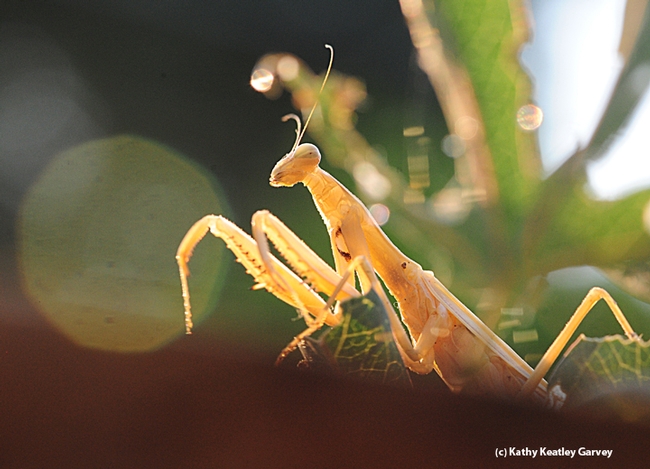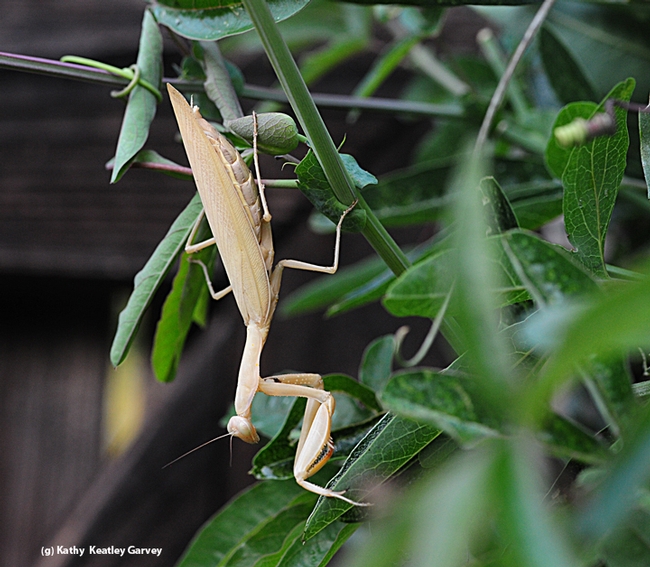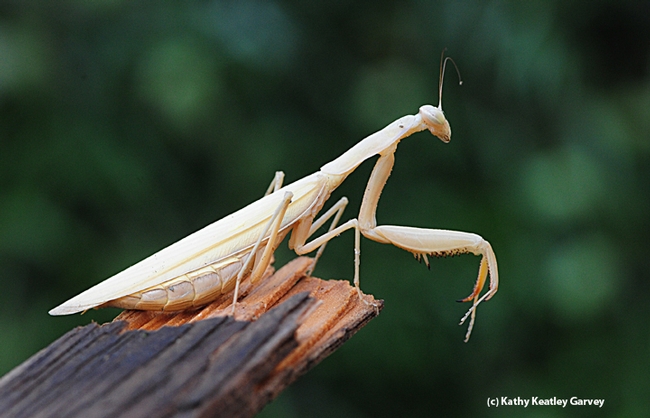- Author: Kathy Keatley Garvey
Those passion flowers (Passiflora) are insect magnets.
One minute you'll see a praying mantis on a blossom. The next minute, a Gulf Fritillary, Agraulis vanillae. And the next morning, the blossom is an arthropod magnet--the beginnings of a spider web.
Passiflora is the host plant of the Gulf Fritillary, a spectacular orange butterfly with silver-spangled underwings. The Gulf Frit lays its eggs only on Passiflora.
The Gulf Frits know where the Passiflora is. Their predators know where the butterflies are.
The female mantis, Mantis religiosa (below), didn't snag the butterfly. But it did grab and munch on a few Gulf Frit caterpillars.
Ever critter eats in the garden.



- Author: Kathy Keatley Garvey
Will a praying mantis eat a caterpillar?
Short answer: Yes.
For several days, we've been watching a resident praying mantis, a female Mantis religiosa, hanging out in our patch of Passiflora (passionflower), the host plant of the Gulf Fritillary butterfly, Agraulis vanillae.
We grow Passiflora to attract these spectacular orange butterflies with the silver-spangled underwings. They sip nectar, court, mate and lay their eggs. The eggs hatch into hungry caterpillars and skeletonize our plants, which make us look like "bad gardeners" but the scenario makes for a "great butterfly habitat."
This year there's no "bad-gardener" look.
The caterpillars haven't skeletonized our plants.
Then we see Mrs. Religiosa. She does not look gravid, unlike the other mantids in our garden. She is string-bean thin. Praying mantis expert and UC Davis alumnus Lohit Garikipati figures she has already deposited her egg case, or ootheca, and she'll live another month or two.
Last year the Gulf Frits graced us with so many caterpillars that they were the zucchinis of the garden. Too many, too soon. We donated dozens of the 'cats to the Bohart Museum of Entomology, UC Davis, for its open house, and to youngsters engaged in science projects.
But this year, where are all the caterpillars?
In any pollinator garden, you must expect the pollinators, predators and the prey. Lady beetles and soldier beetles gobble up the butterfly eggs, while birds, spiders and wasps prey on the caterpillars.
We've never seen a praying mantis grab a caterpillar, though. Until now.
Oh, look! A butterfly ballet ever so graceful over the head of string-bean thin Mrs. Religiosa.
She ignores them. Then she spots a caterpillar. Easy catch, right?
Right.
Yes, a praying mantis will eat a caterpillar.

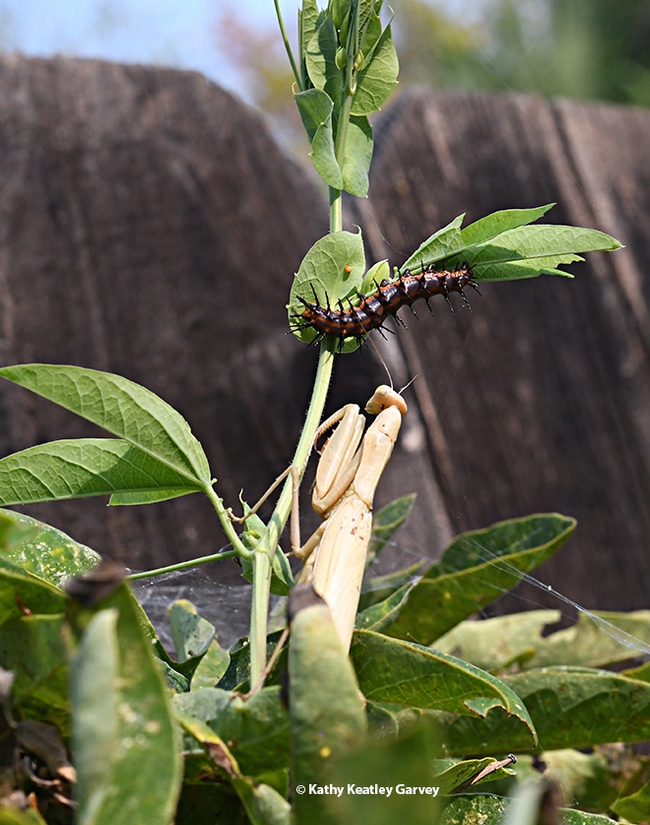

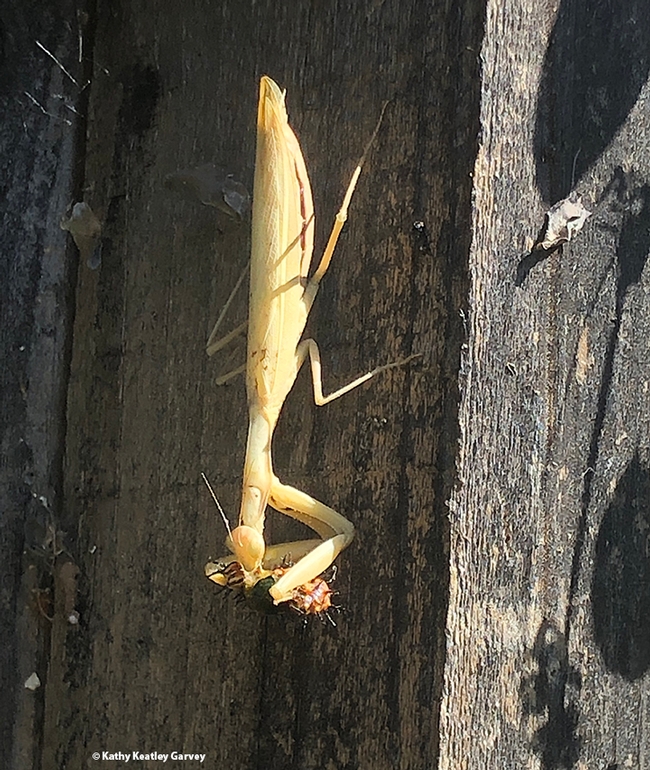
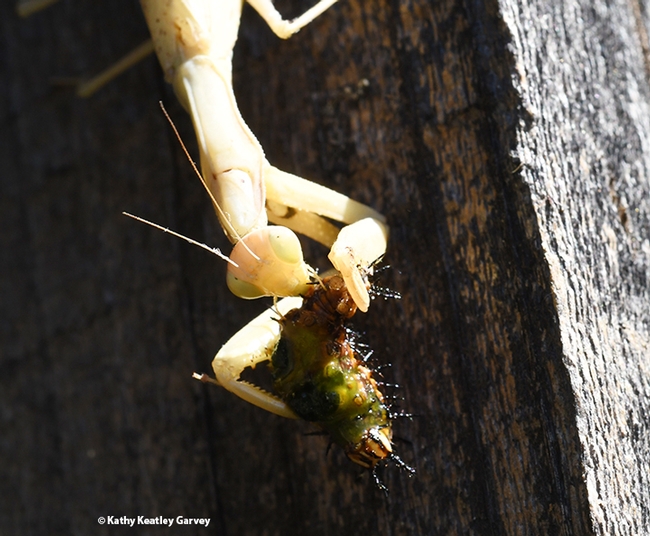
- Author: Kathy Keatley Garvey
The three men pause in front of the Kate Frey Pollinator Garden at the Sonoma Cornerstone and begin to read the sign.
"The Pollinator Garden by Kate Frey," one man reads out loud. "It's brand new, come back soon and watch as it grows. This flower-filled and colorful garden is a pollinator garden. All the plants offer food resources of pollen and nectar for pollinators such as native bees, honey bees, butterflies, hummingbirds and beneficial insects. Pollen is a protein, mineral and fat source and is primarily a larval food for bees, while nectar is composed of various sugars and is the main food for pollination and the adult life stage of many beneficial insects."
They watch the bees, butterflies and hummingbirds--buzzing, fluttering and swooshing--in a rush of colors.
"Beautiful garden," one says.
"Do you want to see a praying mantis?" I ask.
I had earlier spotted a mantis in the vegetation--a female Mantis religiosa (species identified by praying mantis expert Lohit Garikipati, a UC Davis entomology student who rears mantids).
Californians commonly see native mantids, Stagmomantis limbata and Stagmomantis californica, as well as this introduced one, M. religiosa.
"I don't see it," one of the men says. "Where is it?"
"There," I point. "Camouflaged."
"You have a good eye," he comments. "Wow, I haven't seen a praying mantis since I was a kid." He whips out his cell phone for a quick image.
The praying mantis made his day.
It's always a good day when you encounter a praying mantis.
Kate Frey, a resident of Hopland, is the author of the award-winning book, The Bee Friendly Garden, with Professor Gretchen LeBuhn of San Francisco State University, a book that details how to design an abundant, flower-filled garden that nurtures bees and supports biodiversity. She's a two-time gold medal winner at the Chelsea Flower Show and co-founder of The American Garden School. (Read this Bug Squad post to learn her favorite plants and how to attract pollinators.)
As Frey told the crowd at the 2018 UC Davis Bee Symposium, hosted last March by the UC Davis Honey and Pollination Center and the UC Davis Department of Entomology and Nematology: "Whether you plant them, nurture them, or walk through them, bee gardens make us happy."
They do, indeed. Praying mantids do, too.
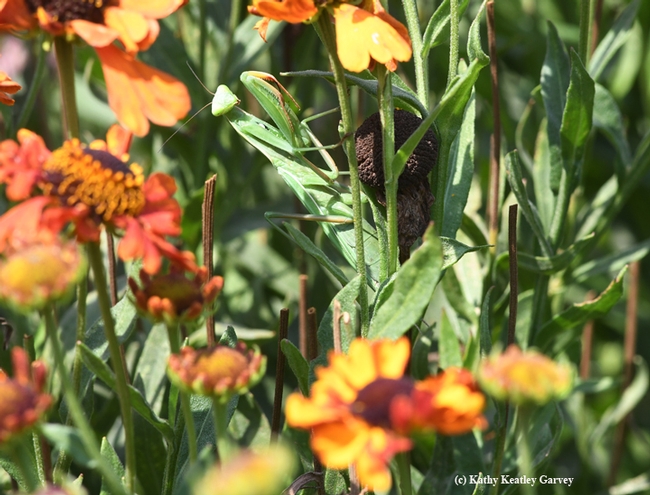
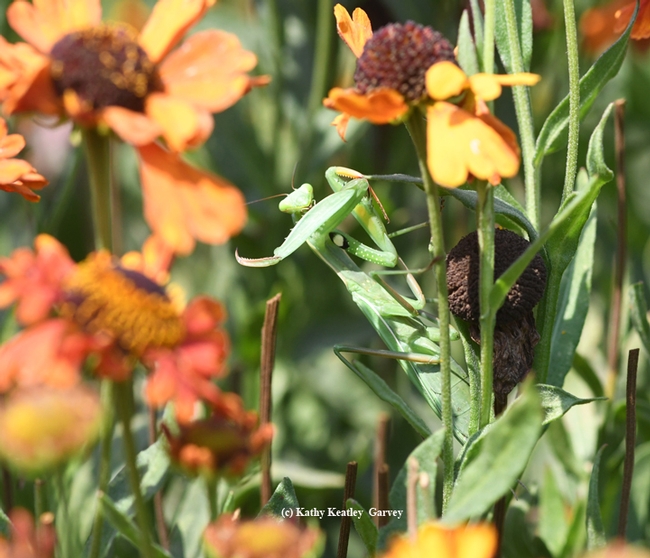
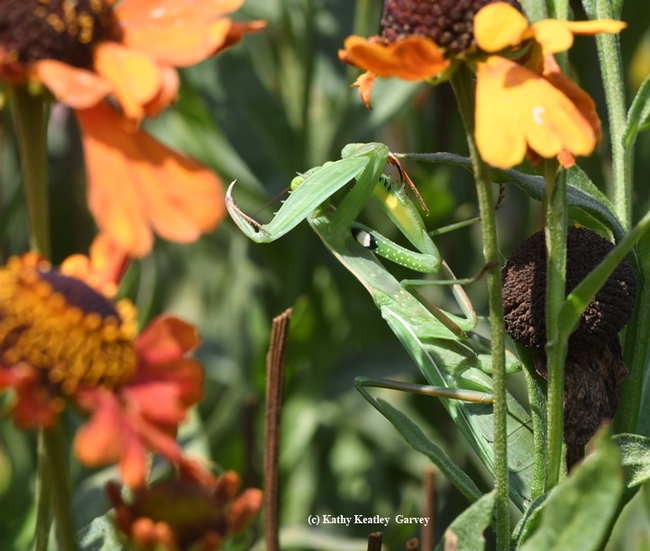


- Author: Kathy Keatley Garvey
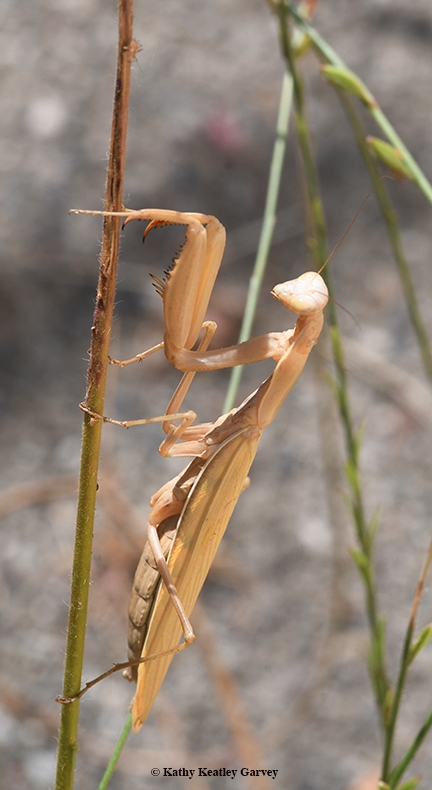
Water a bush or a plant frequently visited by bees and other pollinators, and if they're in there, they're likely to emerge.
Such was the case when a male praying mantis, Mantis religiosa, emerged from our pomegranate bush. No spray zone, please.
Frankly, he looked a bit irritated.
The next week a female M. religiosa emerged from a plant in our neighbor's yard. She, too, looked a bit irritated.
Praying mantis expert, Lohit Garikpati, a UC Davis entomology student who rears mantids and volunteers at the Bohart Museum of Entomology, confirmed their identities and gender.
The European mantis, or Mantis religiosa, belongs to the family Mantidae ("mantids"), the largest family in the order Mantodea. As all insect enthusiasts know, they derive their common name by their distinctive posture of "praying." (Some entomologists like to think of them as "preying" mantids.)
The females are usually larger and heavier but the antennae and eyes of the males outsize the females.
"Along with the forward directed compound eyes there are also simple eyes to be found on the head," Wikipedia tells us. "These three dorsal ocelli are also more pronounced in males than in females.Male individuals are often found to be more active and agile whereas females are physically more powerful. One of the outcomes of these morphological variations is that only males and very young females are able to fly. Adult females are generally too large and heavy for their wings to enable a take-off."
In Germany, M. religiosa is listed as ‘threatened' on the German Red List. That means finders aren't supposed to be keepers: don't catch it or keep it as a pet.
The status of the male and female mantids in our neighborhood? They're still there in their respective yards. If they meet, however, the male may lose his head in the well documented phenonomen of sexual cannibalism...nature's way of better survivability--not for the male but for his offspring!
"Eating her mate provides the female with a lot of nutrients she doesn't have to hunt for," according to Wikipedia. "She has a prey item available that is bigger than the prey she would be able to catch in the manner she usually hunts. The meal also takes place during or shortly after she was fertilized giving her more resources for the faster production of a large ootheca with large eggs, increasing the chance of her offspring to survive. Males have also been known to be more attracted to heavier, well-nourished females for this reason."
There's a lesson in there somewhere!
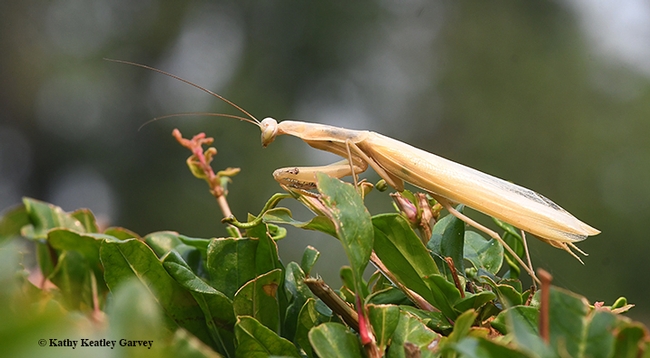
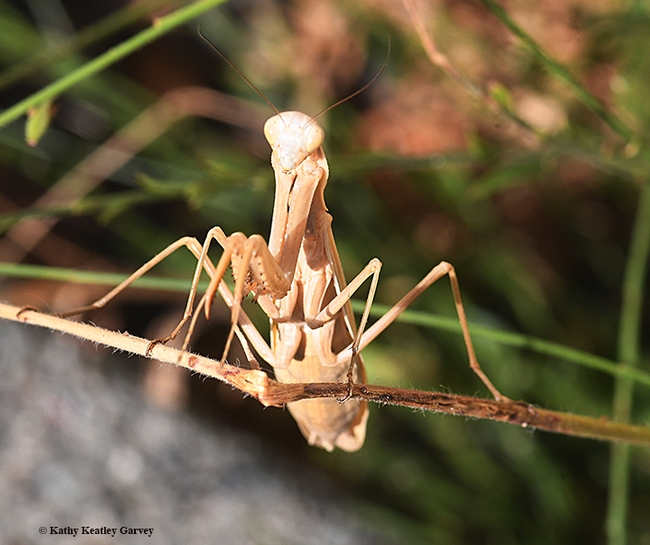
- Author: Kathy Keatley Garvey
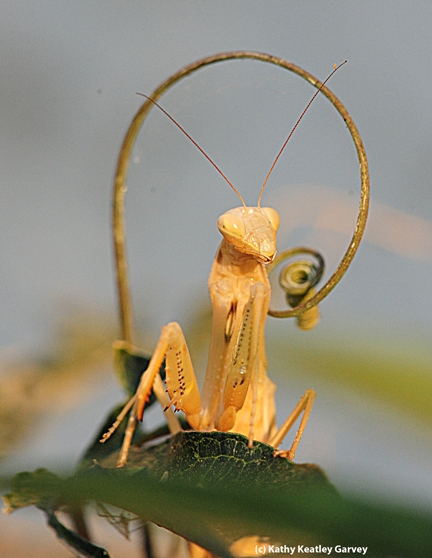
A European praying mantis, Mantis religiosa, hangs out in our passionflower vine, Passiflora, the host plant of the Gulf Fritillary butterfly.
Mantis religiosa is an introduced species, that is, non-native.
We introduce ourselves. She stares at the photographer, and the photographer stares back. There's an old saying "Take a picture; it'll last longer" and I do.
She appears ready for her portrait. She's already eaten her fill of butterflies and the sun is setting. The day is almost done.
We could say she's a lean, green, eating machine, but she's neither lean nor green but she is an eating machine.
Praying mantis expert Andrew Pfeiffer of Monroe County, North Carolina, administrator of the Facebook page, Mantis Keepers, says she probably eats caterpillars as well as the adult butterflies. (And just about anything else she can catch. That's what mantids do.)
It's a myth that colors determine the gender of a mantis. “Many myths surround the mantids, most of which are merely superstition or made up,” he told us (See feature on Bug Squad blog). “Colors do not determine the sex of the mantis, with both males and females capable of being different colors. Mantids are capable of changing the color of their body, but only after molting. A green mantid can turn brown in just one molt.”
Fact is, praying mantids fascinate us, and not just when they're "praying," "preying" or eating.
This mantis, nicknamed "My Buddy," is not alone. Two other praying mantids, known as "My Other Buddies," live in our family's pollinator garden and both are the native Stagmomantis limbata, as identified by Pfeiffer. California has only a handful of mantid species, Pfeifer says. The natives include Stagmomantis limbata, Stagmomantis californica and Litaneutria minor. Introduced ones: Mantis religiosa, Tenodera sinensis and Iris oratoria.
"My Other Buddies" are both gravid females, as well. One is green and hangs upside down on the milkweed, blending in with the greenery while it ambushes assorted bees. The other, also green, prefers to perch in a patch of red/yellow lantana, camouflaged amid the green leaves and stems. There it snags assorted Lepidoptera--skipper butterflies, cabbage white butterflies and moths.
The three have never met.
Let's hope they don't.
